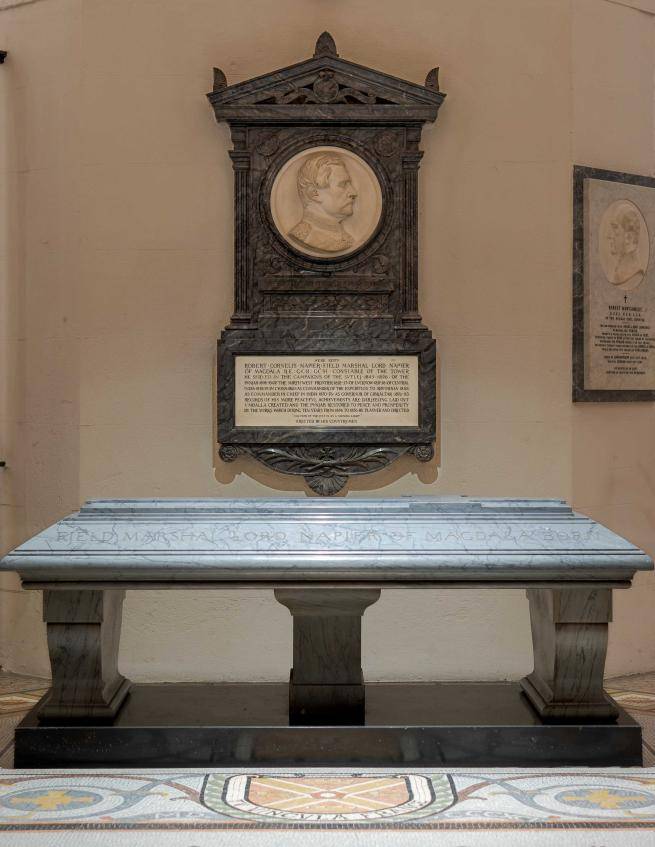Robert Cornelis Napier, 1st Baron Napier of Magdala (1810-90)

Image courtesy of Pantheons: Sculpture at St Paul's Cathedral.
Robert Cornelis Napier
1st Baron Napier of Magdala (1810-90)
This work is part of The East India Company at St Paul’s: A digital trail produced in collaboration with Stepney Community Trust.
Written by Taryn Khanam BEM, CEO of BritBangla. She was awarded the Queen’s Honours for her services to diversity in government and to the Bengali community. She serves on multiple charities and non-profit boards.
The following text is available in Bengali, Gujurati, Urdu, Hindi, Punjabi, and Tamil. Please email CollectionsDepartment@stpaulscathedral.org.uk to request a copy.

![]()
My family hail from the Bengal region. We remember the Battle of Plassey in 1757 as a fateful event when the Nawab of Bengal called Siraj-ud-Daulah, was betrayed by his Commander-in-Chief Mir Jafar (Meer Jaffar), and suffered defeat at the hands of Robert Clive. Clive was appointed Governor of Bengal, and the East India Company secured the right to collect tax revenues from Bengal, laying the groundwork for the establishment of Company rule in India.
Exactly one century later, Robert Cornelis Napier saw action in the 1857 Indian Rebellion, during which local people and Indian soldiers united in opposing the East India Company’s economic exploitation, territorial annexations, displacement of Indian rulers and chiefs, and discrimination against Indian soldiers within the Company armies. Napier successfully captured and executed rebel leaders Man Singh and Tantia Topi, playing a critical role in suppressing the Mutiny.
Before the Indian Mutiny, Napier had served as a captain and engineer in various military sieges carried out by the East India Company to extend its territories. The floor beneath Napier’s memorial chapel contains the names of the key locations associated with the Anglo-Sikh Wars, campaigns in the North-West Frontier Province, and the suppression of the Indian Mutiny. These include Lucknow, Goojerat (Gujarat), Mooltan (Multan), Sobraon, Ferozeshah (Feroe Shah), Jowra Alipore (Alipur), Powrie, Rannode, Taku, and Arogi.
Napier later took command of Indian troops from Calcutta (Kolkata) to fight in the Second Opium War, which the British waged against the Chinese over the right to import cheaply-farmed Indian opium into China. China had banned the illicit opium trade due to the harmful effects of addiction on its people, but the British needed open trade in order to balance its trade deficit. For his part in securing a British victory which led to the forced legalisation of the opium trade in China, Napier received praise from the Parliament and was promoted to General in 1861.
In 1868, the British Prime Minister authorised Napier to lead the Magdala Expedition. Napier led an army of 13,000 Indian soldiers from the Bengal and Bombay armies to free a few British hostages that included the British envoy and diplomats, who had been held for several years by Emperor Tewodros II of Abyssinia (Ethiopia). The expedition was designed to demonstrate Britain’s strategic footprint in Africa. Before destroying the emperor’s artillery and fortress, Napier allowed his troops to pillage Magdala. The National Army Museum notes that ‘It took 15 elephants and 200 mules to transport looted treasure back to the coast, many of which are still held in the British Museum.’
For detailed information about this monument, visit the Pantheons: Sculpture at St Paul's Cathedral website.

The East India Company at St Paul's
Explore the full digital trail produced in collaboration with Stepney Community Trust.




